|
< Earlier Kibitzing · PAGE 3 OF 3 ·
Later Kibitzing> |
| Sep-04-09 | | johnlspouge: < <CHESSTTCAMPS> wrote: <AxelBoldt: 21.Rd7 Bxd7 22.Rxd7 Rad8 sucks a bit.> Rather more to the point than my comment on this line. > My tactical analysis missed that the White Kg1 was vulnerable to back-rank mate, and with the omission, this variation. You make a terse observation, <AxelBoldt>, perhaps not with my choice of vernacular, but I thank you, too. |
|
| Sep-04-09 | | dzechiel: <johnlspouge: Incidentally, for a guy in California, you spell "defense" rather strangely.> I noticed that years ago. My formative years were spent studying chess openings, where most of the Defences use the British spelling. I understand the American spelling is "defense", but I got into the habit of using the other and no longer think about it (until someone like you points it out). :) |
|
| Sep-04-09 | | kevin86: The first move was easy-the rest was above my pay grade. |
|
| Sep-04-09 | | YouRang: I join those who fell into the trap:
21.Rd7?! <"brilliant" exchange sac> Bxd7 22.Rxd7? <wrongly thinking that I was forcing the queen to move> Qb4?? <also wrongly thinking the same thing> 23.Rg7+! Kh8 24.Nf7# (or 23...Kf8 24.Nd7#). Beautiful! That is until I checked with the computer and it informed me about 22...Rad8! :-( |
|
| Sep-04-09 | | dhotts: Can someone expalin how WHite wins after 21.Nxg6 Qf7 22.Rd8 Qxg6! White needs to keep the attack going as his Queen is en prise. So the best I have is 23.Rxf8+ Qxf8 24.Rd3 Bf8 and black looks like he can wheather the storm? |
|
Sep-04-09
 | | Jimfromprovidence: <krippp> <Rybka reveals that <23.Rxe8+> would have been the strongest here. At first it seems pointless compared to <23.Nxe5>, but the very clever follow-up <24.c5!> gives White an overwhelming advantage. The move cuts through both of Black's best defences perfectly:> I really liked this line. 24 c5 is one great move.
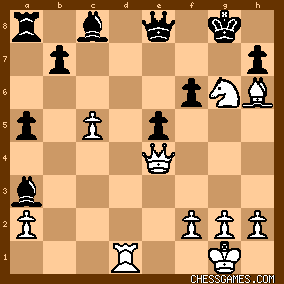
click for larger viewThe immediate threat is 25 Rd8 with forced mate. If black tries 24…Bxc5, then 25 Rd8 anyway. Black cannot capture the rook with 25…Qxd8 because 26 Qc4+ (below) is forced mate. (because by taking the rook black gives up control of the e6 square.

click for larger viewThe best follow up <24...Ra6 25.Qd5+ Re6 26.Nf8>, leads to a fun, derivative puzzle. After 26… Qe7 below, what is white’s best move?

click for larger view |
|
| Sep-04-09 | | CHESSTTCAMPS: <hotts: Can someone expalin how WHite wins after 21.Nxg6 Qf7 22.Rd8 Qxg6!...> Simply 23.Qxg6+ hxg6 24.Rxe8+ Kh7 25.Be3 and black must lose more material to R1d8. |
|
| Sep-04-09 | | David2009: Saturday's puzzle Uhlmann vs R Schoene, 1991 White to play 21? Difficult There has to be a catch - this looks like a Tuesday/Wednesday puzzzle.
White levels the material with 21 Nxg6 expecting hxg6 22 Qxg6+ Kh1 23 Bg7+ Qxg7 24 Qxe8+ Bf8 25 Rd8 etc.
Material is nominally level but Black's King and back rank are far too exposed for survival.
If Black declines the N with 23...Qf7 24 Rd8 follows and if hxg6, (Qxg6 allows QxQ then RxR winning on material) Black is checkmated quickly after 25 Rxe8+ Qxe8 26 Rd8,
e.g. 26...Qxd8 27 Qxg6+ Kh8 Qg7#; or 26...f5 27 Qe5.
Time to check.
====
I missed the game continuation 23..Qf7 24 Rd8 e5! which poses White interesting problems. Time to ponder the position further, and to digest other people's comments. |
|
Sep-04-09
 | | ajk68: <johnlspouge> and <dzechiel>: Interesting...I grew up in CA and have occasionally spelled "defense" as "defence." I frequently give pause when I have to write that word. Maybe it's a Calfornia thing too. |
|
Sep-04-09
 | | doubledrooks: I saw that the tempting 21. Rd7 leads nowhere after 21...Bxd7 22. Rxd7 fxe5 23. Rxe7 Rxe7. Then I went with 21. Nxg6.
If 21...Qf7 22. Rd8 then both
a. 22...Qxg6 23. Qxg6+ hxg6 24. Rxe8+
and
b. 22...hxg6 23. Rxe8+ Qxe8 24. Rd8 Qxd8 25. Qxg6 Kh8 26. Qg7# win. However, I didn't look at 22...e5. |
|
| Sep-04-09 | | Athamas: Interesting find with c5. I completely forgot about white's pawns when I was solving the puzzle. Quite instructional that a simple pawn block is so powerful even in the midst of a massive piece attack. Also I'm curious to my Qc7 line. Was my analysis wrong if Qg4 to respond or was Ne7+ necessary like I finally ended on? |
|
| Sep-04-09 | | alphee: Really missed this one. The only attempt that looked like something was 21. ♖d7 ♗xd7 22.♖xd7 ♕d6 23. ♖g7+ ♔h8 24. ♘f7# and I knew it was not the solution. Well it is friday ... |
|
| Sep-04-09 | | Knight13: Saw everything.
Did not expect Friday to be this easy. |
|
Sep-04-09
 | | Jimfromprovidence: <Athamas> <Also I'm curious to my Qc7 line. Was my analysis wrong if Qg4 to respond or was Ne7+ necessary like I finally ended on?> After 21…Qc7 22 Qg4 e5, below, to try to stop the threat of Ne7+,then Qg7#, the position is a forced mate (per Rybka freeware).
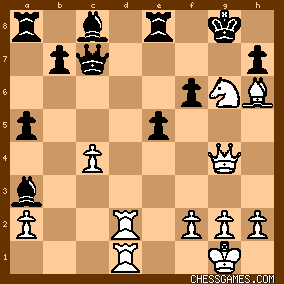
click for larger view
The key moves are two consecutive rook interference ones. First comes 23 Rd7! (Again with the threat of Ne7+,then Qg7#).
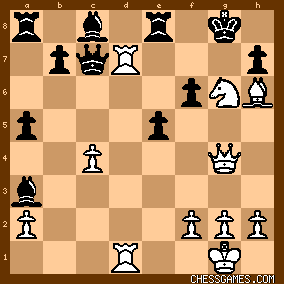
click for larger view
Now, after 23…Bxb7, 24 Rxd7 24 Qxd7 25 Qxd7, the position is below.
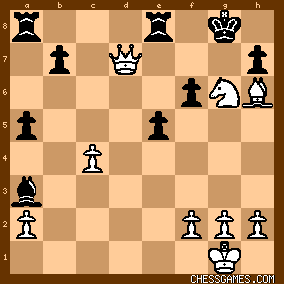
click for larger viewWhite now mates nicely with something 25…Re7 26 Qd5+ Rf7 27 Nh8! Kxh8 28 Qxf7 29 Bxf8 Rxf8 30 Qxf8#. |
|
| Sep-04-09 | | Athamas: Thanks Jim. I had thought about Rd7 briefly but I assumed it didn't work for some reason. |
|
| Sep-04-09 | | CHESSTTCAMPS: The problem with variation B in my original post, (22.Ne5 instead of the text Rd8!) seems to be that white can get the piece back, but at the cost of exchanging queens. After 22... fxe5 23.Rd3 Be7! (a move I didn't consider) we reach this position: 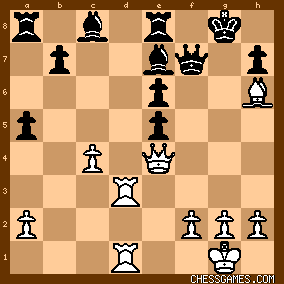
click for larger viewNow white can't seem to do any better than 24.Rf3 Bf6 25.Bg5 Qg6 26.Qxg6+ hxg6 27.Rxf6 Kg7 ...and white doesn't seem to have much pull in this opposite-colored bishop ending. |
|
Sep-04-09
 | | OBIT: I'm looking at this a bit late, I suppose, but better late than never. So let's see, Friday puzzle, should be a toughie.... Well, the first idea I consider is 21. Nxg6 hxg6 22. Qxg6+ Kh8. Now I'd have mate if I can just divert the queen, and, hmm.... doesn't 23. Rd8 do that? What can Black do to stop RxR+ QxR and Qg7#? Obviously, if 23...Bd7 I just take play RxB. That seems to do it. Game over. But wait a second... this puzzle is rated difficult! Something appears to be amiss here, because this combination certainly isn't that tough. I must be missing something, better recheck. Hmm, knight takes the pawn, threatens to take the queen with check. The queen can't make any moves that threaten anything, so the only move I need to analyze is the capture of the knight. But after Qxg6+, obviously Black has only one move, and then comes Rd8 and it's over.... right? OK, something definitely seems fishy, but I know I'd play Nxg6+. Lemme me what happened... |
|
| Sep-04-09 | | wals: [Event "GER-ch"]
[Site "03"]
[Date "1991.??.??"]
[Round "?"]
[White "Wolfgang Uhlmann"]
[Black "Ralf Schoene"]
[Result "1-0"]
[ECO "D31"]
[Annotator "Rybka 3 1-cpu (30m)"]
[PlyCount "55"]
{D43: Semi-Slav:
1. c4 e6 2. Nc3 d5 3. d4 c6 4. Qb3 Nf6 5. Nf3 a5 6.
e3 Nbd7 7. Bd3 g6 8. O-O Bg7 9. e4 dxe4 10. Nxe4 (10. Bxe4 O-O) 10... Nxe4
11. Bxe4 ♗lack's piece can't move: c8 O-O 12. Bf4 (12. Bg5 Qc7 ) 12... c5
13. dxc5 (13. Bd6 cxd4 14. Rad1 Re8 13... Nxc5 ♗lack has a cramped
position (13... f5 14. Bc2 e5 15. c6 bxc6 16. Bg5 ) 14. Qe3 Nxe4 15. Qxe4 (
15. Rad1 Qe7 16. Qxe4 Rd8 ) 15... Bxb2 ♗lack has the pair of bishops (
15... Qb6 16. Be5 ) 16. Rad1 White threatens to win material: ♖d1xd8 Qf6
17. Rd2 (17. h3 Qf5 18. Qe3 Bg7 ) 17... Ba3 18. Rfd1 (18. Rd3 Bc5) 18...
Qe7 ♗lack has a cramped position. ♗lack's piece can't move: c8 (18... Qf5
19. Qe3 Bc5 ) 19. Ne5 f6 ?? <blunder> Controls g5 (19... Bb4 saving the
game 20. Rd3 Qh4 ) 20. Bh6 Re8 ? <dubious> (20... f5 21. Qf3 Qh4 22. Bxf8 Bxf8
) 21. Nxg6 ! ♙inning: g7 Qf7 (21... hxg6 22. Qxg6+ ♙inning) (21... --
22. Nxe7+ Mate threat) 22. Rd8 e5 23. Nxe5 Decoy: f8 fxe5 (23... fxe5
24. Rxe8+ Decoy) (23... -- 24. Nxf7 Mate threat) 24. Rxe8+ Qxe8 25. Rd3 Ra6
26. Qd5+ Qe6 ?? <blunder> terrible, but the game is lost in any case (26... Qf7 27.
Rg3+ Bg4 28. Qd8+ Bf8 29. Rxg4+ Rg6 30. Rxg6+ hxg6 31. Bxf8 Qxf8 32. Qxf8+ Kxf8
) 27. Qd8+ Kf7 28. Rf3+ (28. Rf3+ Qf6 29. Qc7+ Be7 30. Bg5 Qxf3 31. Qxe7+
Kg6 32. gxf3 ) (28. Rxa3 Qxh6 29. Rf3+ Rf6 30. Qc7+ Kg8 31. Qxc8+ Qf8 32.
Qxb7 Rxf3 33. Qxf3 Qb4) 1-0
The above may be of interest to those seeking help. |
|
Sep-04-09
 | | OBIT: So, I see Black did not take the knight, which is what I halfway expected, but I think this is all that needs to be seen before deciding on the move OTB. After 21...Qf7, 22. Rd8 is not hard to see, since the knight still can't be captured (22...hxg6 23. Rxe8+ Qxe8 24. Rd8 or 22...Qxg6 23. Qxg6+ hxg6 24. Rxe8+). In positions like this, where you are attacking and haven't sacrificed anything, I think you can take the moves as they come and not worry about analyzing out the whole thing ahead of time. |
|
| Sep-04-09 | | WhiteRook48: I thought of 21 Rd7 winning the queen, but 21...Bxd7 22 Rxd7 fxe5! 23 Rxe7 Bxe7 24 Qxe5 Bf8 allows way too much compensation for the queen |
|
| Sep-05-09 | | TheBish: Uhlmann vs R Schoene, 1991 White to play (21.?) "Difficult"
White is down a pawn. I only had one candidate move, which is... 21. Nxg6!
White wins the pawn back, but more importantly, he tears into Black's fortress and opens lines of attack. Accepting the sacrifice seems to be losing. A) 21...hxg6 22. Qxg6+ Kh8 23. Bg7+ Qxg7 (not 23...Kg8?? 24. Bxf6+ winning the queen) 24. Qxe8+ and now: A1) 24...Bf8 25. Rd8 wins one of the bishops (25...Bd7 26. Qxd7). A2) 24...Qg8 25. Qh5+ Kg7 (or 25...Qh7 26. Rd8+ Kg7 27. R1d7+ Bxd7 28. Rxd7+) 26. Rd3 is crushing, since White is going for either the king or queen -- who needs the bishop?! The threat of 27. Rg3+ is so strong, Black has nothing better than 26...Bd6 27. Rxd6, so Black is busted. No better is 26...Qf8 27. Rg3# or 26...Qf7 27. Rg3+ Kf8 28. Qh8+ Ke7 29. Qd8#. A3) 24...Qf8 25. Qh5+ Kg7 26. Rd3 wins, i.e. 26...Qc5 27. Rg3+ Kf8 28. Qh8+ and mate next, or 26...Qf7 27. Rg3+ transposes to the last line in A2. A4) 24...Kh7 25. Rd3 wins at least a piece, i.e. 25...e5 26. Rxa3 or 25...Bf8 26. Rh3+ Kg8 27. Rg3. B) 21...Qf7 22. Rd8! prevents capture of the knight, since 22...hxg6 23. Rxe8+ Qxe8 24. Re8! Qxe8 25. Qxg6+ Kh8 26. Qg7#. Now Black is all tied up, and has several ways to lose: B1) 22...Be7 23. Nxe7+ Qxe7 24. Qg4+ Kh8 25. Rxe8+ Qxe8 26. Qg7#. B2) 22...Bb2 23. Ne5! Bxe5 (or 23...Qh5 24. Qg4+! Qxg4 25. Rxe8#) 24. Qg4+ Qg6 (or 24...Kh8 25. Rxe8+ Qxe8 26. Qg7#) 25. Qxg6+ hxg6 26. Rxe8+ Kf7 27. Rf8+ Ke7 28. Rdd8 wins the bishop and leaves White a rook up. B3) 22...e5 23. Nxe5! (clearing the g-file) fxe5 24. Rxe8+ (not 24. R1d3? Bf5) Rxe8 25. Rd3 Ra6 26. Qd5! Running interference! Now: B3a) 26...Kh8 27. Qxe5+! Qxe5 28. Rd8+ Bf8 29. Rxf8#. B3b) 26...Re6 27. Rg3+ Kh8 (or 27...Kf7 28. Rg7+ Kf6 29. Qf3#) 28. Bg7+ Kg8 29. Bxe5+ Kf7 30. Qf3+ Ke7 31. Qxa3+ Kd8 (or 31...Kf7 32. Rg7#, or 31...Kd7 32. Rd3+ Kc6 33. Rd6+) 32. Rd3+ Bd7 33. Qxa5+ b6 34. Qa8+ wins easily three pawns up. B3c) 26...Be6 27. Rg3+ Kf7 28. Qxb7+ wins the rook.
B3d) 26...Qe6 27. Qd8+ Kf7 28. Rf3+ Qf5 (or 28...Kg6 29. Qg5#) 29. Qxc8! Qxf3 30. gxf3 Rxh6 31. Qxb7+ Be7 32. c5 and the c-pawn will roll on. |
|
| Sep-05-09 | | whiteshark: What's wrong with <22...f5>? Attacking Qe4, and Ng6 is still hanging. 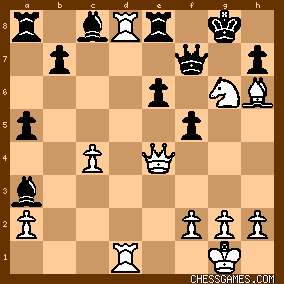
click for larger view |
|
| Sep-05-09 | | krippp: <whiteshark> It leads to mate, e.g. <23.Qe5 Qxg6 24.Rxe8+ Kf7 25.Qc7+ Kf6 26.Qd8+ Kf7 27.Rf8+ Bxf8 28.Qxf8#> |
|
| Sep-05-09 | | whiteshark: Thanks <kripp>. I missed that the protection of Re8 with the queen was an illision, due to Qg7#. |
|
| Sep-06-09 | | 5hrsolver: It seems to me that instead of 23..fxe5 black can play 23..Bf5 counter attacking the white queen and connecting the black rooks. It seems to me that this holds for black. Which leads me to think that 23.Nxe5 is not the best move for white. I looked at Jimfromprovidence line of 23.Rxe8 Qxe8 24.c5!. I think this is the winning line for white. I have analyzed some lines (in addition to Jimfromprovidence analysis). Here is one line 23.Rxe8+ Qxe8 24.c5 Be6 25.Qxb7 Bf7 26.Ne7+ Kh8 27.Nc6 Bxc5 28.Rd7 Kg8 29.Rxf7 winning a piece. |
|
 |
 |
|
< Earlier Kibitzing · PAGE 3 OF 3 ·
Later Kibitzing> |





